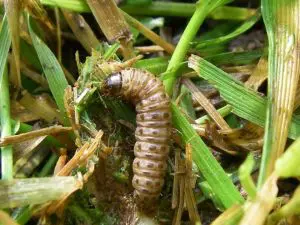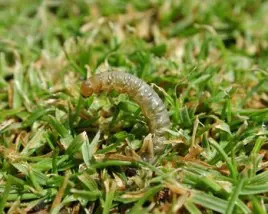Sod Webworm – Catepillars in the Lawn?
 Sod webworms are the caterpillar or larval stage of what are commonly called “lawn moths.” When they are in the larvae stage the caterpillars need a food source, and what is better than the homeowner’s lawn. As the larvae age, they begin feeding more and this is when damage can easily be seen. Unfortunately, sod webworms can go through as many as 10 larval stages before they pupate. The entire life cycle from egg to adult can take three to seven weeks. One positive is that the moth (adult) stage won’t do any harm to your lawn!
Sod webworms are the caterpillar or larval stage of what are commonly called “lawn moths.” When they are in the larvae stage the caterpillars need a food source, and what is better than the homeowner’s lawn. As the larvae age, they begin feeding more and this is when damage can easily be seen. Unfortunately, sod webworms can go through as many as 10 larval stages before they pupate. The entire life cycle from egg to adult can take three to seven weeks. One positive is that the moth (adult) stage won’t do any harm to your lawn!
Sod webworm damage usually starts as small spots of browning turf that can grow and coalesce as feeding continues. Patches are irregular in shape and start to thin and turn brown. Sod webworms congregate in dry, drought-stressed areas, so irrigation/rainfall is important.
 If you are wondering why grass may be turning brown, there are a few simple tests that can take place for you to diagnose the issue. Sod webworms feed at night, so if you are in your lawn around dusk, you can look through the grass. If you find tiny worms crawling, green color excrement on a damaged (brown) area or eggs then your lawn has sod webworm damage.
If you are wondering why grass may be turning brown, there are a few simple tests that can take place for you to diagnose the issue. Sod webworms feed at night, so if you are in your lawn around dusk, you can look through the grass. If you find tiny worms crawling, green color excrement on a damaged (brown) area or eggs then your lawn has sod webworm damage.
Your other option to help diagnose is the drench test. In a 36” x 36” area you will mix 1 ounce of Dawn to 1 gallon of water. Pour this into the area and if you see more than 15 larvae it would dictate sod webworm activity.
As always Go Green Customized Lawn care recommends proper mowing heights as many native grasses in the Mid-Atlantic area were bred for a 4-5” height of cut with your mower.

